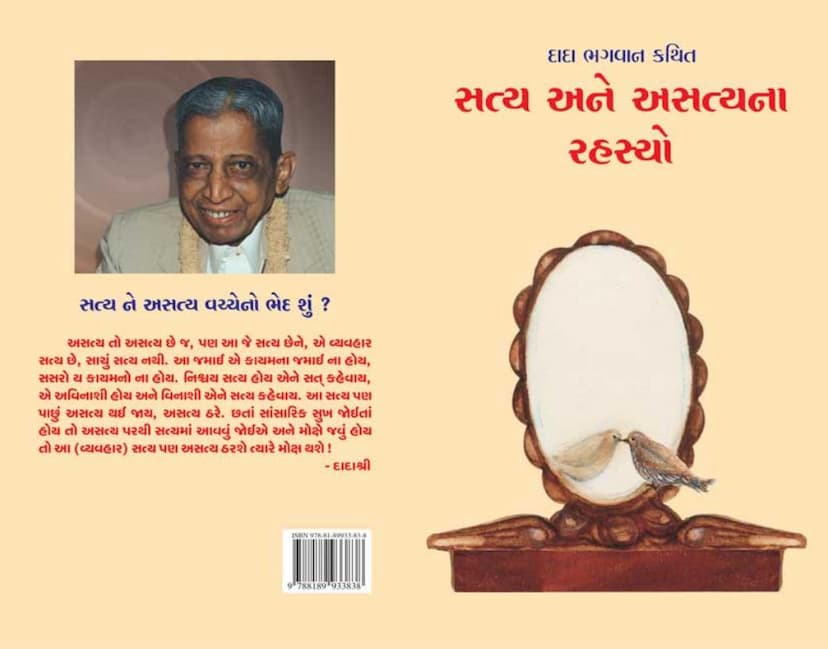Satysa Asatya Na Rahasyo
Added to library: September 2, 2025

Summary
This document is a summary of the Jain text "Satya Asatya Na Rahasyo" (Secrets of Truth and Untruth) by Dada Bhagwan, published by Dada Bhagwan Foundation.
The core message of the book revolves around the distinction between 'Sat' (absolute truth) and 'Satya' (relative truth or transactional truth).
Here's a breakdown of the key concepts presented:
-
The Nature of 'Sat' vs. 'Satya':
- 'Sat' is the eternal, unchanging, indestructible essence. It is the Soul (Atma) or the Pure Self. It is always true and universally acceptable.
- 'Satya' (transactional truth) is relative, dependent on perspective, context, and time. It is impermanent and can change. For example, a son-in-law is a son-in-law only as long as the relationship exists; a father-in-law is also not permanent in that role. This transactional truth is also called 'Vinaashi' (destructible).
- The book emphasizes that 'Satya' can eventually turn into 'Asatya' (untruth).
-
Purpose of Transactional Truth:
- If one desires worldly happiness and peace, it is necessary to move from untruth ('Asatya') towards transactional truth ('Satya').
- However, to attain Moksha (liberation), one must realize that even this transactional truth ('Satya') is ultimately not the ultimate reality ('Sat'). Only when one transcends this relative truth can Moksha be achieved.
-
Subjectivity and Relativity of 'Satya':
- What is considered true in one context or for one group of people might be untrue for another. For instance, consuming meat might be wrong for Hindus but acceptable for Muslims. This highlights the relative nature of transactional truth.
- The book stresses that 'Satya' is subjective and depends on viewpoint and is often tied to societal norms, laws, and personal beliefs.
-
The Real Truth is 'Sat':
- The ultimate, unchanging truth is the Soul ('Sat'). This is the eternal and indestructible element.
- The worldly truth ('Satya') is considered 'Asatya' in the eyes of the Absolute Truth ('Sat').
- The book clarifies that there is no 'Sanatan Satya' (eternal truth) in the worldly sense, but there is 'Sanatan Sat' (eternal essence/reality).
-
The Role of 'Satya' in Life:
- While transactional truth ('Satya') is necessary for worldly interactions and maintaining social order, it is not the ultimate reality.
- In worldly dealings, it's important for 'Satya' to be beneficial (hit), dear (priya), and concise (mit). Speaking truth that causes harm or distress is not considered true 'Satya'.
- The book advises against clinging rigidly to transactional truth, as it can become an obstacle to spiritual progress.
-
Moksha and Transcending 'Satya':
- The path to Moksha involves transcending all dualities – merit/demerit, happiness/sorrow, good habits/bad habits. This state is 'Dvandvatit' (beyond dualities), where the relative truth ('Satya') loses its significance in the face of the Absolute Truth ('Sat').
-
Practical Guidance:
- The teachings encourage understanding the relative nature of worldly truths and not becoming attached to them.
- When faced with difficult situations, it's advisable to act with the intention of causing minimum harm, even if it involves navigating through relative untruths. This is often framed as "nissvārtha kapat" (selfless deception) or "drama" in worldly interactions to maintain harmony and avoid unnecessary conflict.
- The emphasis is on reducing inner conflict and maintaining equanimity rather than rigidly adhering to a perceived absolute truth in all transactional matters.
- The book strongly advocates for 'Pratikraman' (repentance/atonement) when one knowingly or unknowingly deviates from the right path, as a way to purify oneself and mitigate karmic consequences.
In essence, "Satya Asatya Na Rahasyo" guides the reader to understand that worldly truths are temporary and relative, while the ultimate reality lies in the eternal and unchanging nature of the Soul ('Sat'). The journey to liberation involves recognizing this distinction and gradually letting go of attachment to transactional truths.